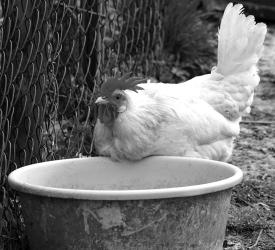Take steps now to help protect your poultry.
The Centers for Disease Control and Protection (CDC) reports that H5N1 avian influenza (bird flu) “is widespread in wild birds worldwide and is causing outbreaks in poultry and US dairy cows with one recent human case in a US dairy worker.”
Migratory waterfowl promote transmission of avian influenza (AI). Spring’s moist, cool days provide an ideal environment for AI to spread through puddles and ponds.
Commercial poultry firms generally work with their veterinarian to monitor AI conditions. Those desiring to protect small flocks will find online poultry biosecurity information and a program provided at no cost by the University of Nebraska-Lincoln (UNL).
Dr. Don Reynolds, DVM, PhD, DACVM, UNL Professor and Poultry Veterinarian, says a biosecurity program is the best defense against production losses caused by diseases such as AI.
“Once a disease begins to spread,” Reynolds says, “it becomes difficult to control at best and impossible at worst. The best strategy is to prevent disease- causing organisms from reaching your flock. A strong biosecurity program helps accomplish that.”
Biosecurity is a set of management practices designed to prevent diseases from spreading to animals. Because diseases like AI can be carried onto a farm on visitors’ shoes, by wildlife, or through contaminated litter or feed, it’s essential to identify areas of weakness throughout a farm and production system and create a plan that reduces the potential for spreading this disease through any unprotected area. Implementation of biosecurity practices is often overlooked by those raising small flocks.
Because small backyard flocks are often housed in open areas, they are easily exposed to wild birds and waterfowl. These small flocks may share the same ponds, puddles, and water sources as wild birds.
“One practice we stress for small flocks is placing feeders and waterers in places where wild birds can’t access them,” Reynolds says. “If possible, keep them inside or at least in an area where wild birds can’t fly through fencing to get to them because wild waterfowl are primary hosts for AI. Be aware that simply monitoring your poultry for signs of AI isn’t likely to be adequate. The first signs of the presence of this disease may be dead birds. Clinical signs exist, but not all poultry owners may detect the symptoms.”
Clinical signs of AI may include: •Sudden death without clinical signs.
•Lack of energy and appetite.
•Decreased egg production or soft-shelled or misshapen eggs.
•Swelling of the head, comb, eyelid, wattles, and hocks.
•Purple discoloration of wattles, comb, and legs.
•Nasal discharge, coughing, and sneezing.
•Lack of coordination.
•Diarrhea. Other diseases can cause some of these same or similar clinical signs of disease. Those include Newcastle disease and infectious bronchitis.
“A good biosecurity plan will consist of measures that create a barrier between potential exposure and animals,” Reynolds says. “Results of a targeted biosecurity plan are healthier animals and a more profitable enterprise.”
The program provides education about biosecurity specific to poultry, helping poultry producers evaluate the biosecurity risks specific to their operation and establish a biosecurity program to reduce risk and protect their flock against the introduction of disease and spread of disease.
UNL’s Big Red Biosecurity Program was developed by a poultry veterinarian and professor in the School of Veterinary Medicine and Biomedical Sciences at UNL. The program covers all poultry: chickens, turkeys, gamebirds, etc. It is designed for use by all sizes of farms, including commercial, niche market, or backyard production. Biosecurity templates and online training help in developing a site-specific plan.
“If a producer believes their birds may be infected with AI, they should contact their local veterinarian, state veterinarian office, the USDA, or if located in Nebraska, call me,” Reynolds says. “We complete testing at no cost to the owner. Tracheal swabs will be taken and tested for the disease at our Nebraska Veterinary Diagnostic Center.”
The results of the tests are available on the same day. The owner receives a report if testing results are negative and no further action is taken. Federal (USDA) and state veterinarians are informed if the flock tests positive and take over the investigation. Samples are immediately sent to the National Veterinary Services Laboratory (NVSL) for confirmation. The premise where the flock is housed will be quarantined. Typically, birds are humanely euthanized and disposed of in a bio-secure manner.
Following depopulation, owners receive indemnity payments, and owners and other personnel are monitored for influenza by the public health department.
“It’s important to understand that there is a low probability of infecting humans,” Reynolds says. “But AI is zoonotic. It can be transmitted to humans. Eggs and poultry products are not transmitters of the disease to people.”
Steps to help reduce the potential for AI in your poultry include: ·Limit exposure of birds to the outdoors (at least until warm summer weather) ·Avoid poultry exposure to ponds, puddles, etc.
·Keep wild birds (especially waterfowl) away from your flock.
·Beware of wild birds using your feeders and waterers and prevent it.
·Limit human visitors, especially those who also have poultry.
·Limit exposure to other birds at shows, meets, swaps, etc.
·Quarantine any newly acquired birds in a separate facility away from other birds for two weeks.
·Routinely correctly clean and disinfect waterers, feeders, coops, etc.
Big Red Biosecurity provides up-to-date biosecurity information online 24/7. Educational modules and a Biosecurity Training Certificate program are available online through the site. In addition, an NPIP Biosecurity Audit Preparation program is available, and a UNL poultry veterinarian is available to answer questions about biosecurity. Please direct veterinary care questions to your local veterinarian.
For information about the Big Red Biosecurity Program, visit https://bigredbiosecurity. unl.edu, call 402-472-8810, or email dreynolds2@unl.edu.



